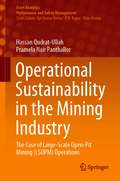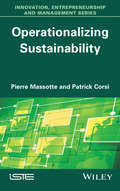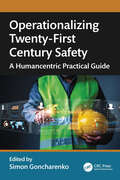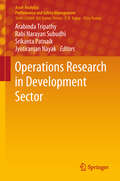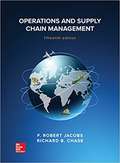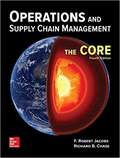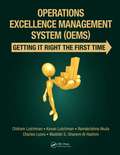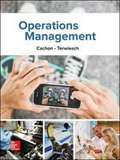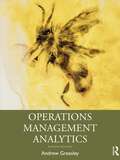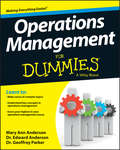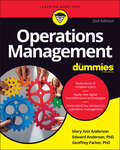- Table View
- List View
Operational Sustainability in the Mining Industry: The Case of Large-Scale Open-Pit Mining (LSOPM) Operations (Asset Analytics)
by Hassan Qudrat-Ullah Pramela Nair PanthallorThis book broadly explains the requirement to focus on core components in a business and provides a case study of open-pit mining operations throughout the book to understand the management perspective of large organizations. With globalized approaches of large businesses and the rising requirement of understanding the needs of modern organizations, it is necessary to focus on key areas of businesses to ensure sustainability of operations. Organizations look into achieving a high return on investments and short-term measures in increasing sales or revenue is considered unsuitable. It is a necessity to look for sustainability and continuous methods of innovation to boost efficiency. This book provides a case study based on large organizations and uses qualitative methodologies where data was collected using in-depth interviews of respondents from various mining companies in the top and middle-level management from different parts of the world, detailing the state of the art of information systems currently used in large scale open-pit miming (LSOPM). This book provides a sound knowledge of cutting-edge factors to the reader for managing the business to attain operational excellence and long-term sustainability, and caters to a broad spectrum of management and technical readers.
Operational and Strategy Review Meetings: Keeping the Organization on a Strategic Trajectory for Breakthrough Performance
by Robert S. Kaplan David P. NortonWith strategy and operational plans in place, the enterprise embarks on executing the strategy: producing and delivering products and services to customers, implementing initiatives, and improving processes. However, like mission control after a spaceship has been launched, the enterprise needs to continually monitor and adjust its performance to achieve strategic objectives. Managers guide the enterprise by holding a structured set of meetings that deal with operational and improvement programs and review the strategy and adjust or transform it as needed.
Operationalizing Sustainability
by Patrick Corsi Pierre MassotteThis book focuses on the emergence of the "science of sustainability" and the key concepts in making sustainability operational in an organization. The authors discuss the methods, techniques and tools needed to manage the impact of sustainability and how these can be reformulated into business models and solutions for new growth and applications. They then move onto the reformulation of future thinking processes before ending by looking towards an approach for the measurement of sustainability and competitiveness.
Operationalizing Twenty-First Century Safety: A Humancentric Practical Guide
by Simon GoncharenkoUnderstanding workplace health and safety can be a minefield and considering how the human can be placed at the heart of it adds another level of complexity to task that already has many factors. This book breaks down key practical aspects of the human factors-based approach to health and safety.Unlike most of the existent human factors resources on the market today, which all require some fluency in the concepts and a certain level of pre-understanding, Operationalizing Twenty-First Century Safety: A Humancentric Practical Guide presents the material in a simple, easy-to-read language that does not require academic background or prior experience to ensure you can deliver lasting results. Revealing the science and psychology behind human factors and performance programs, this fascinating title challenges the status quo and questions why we adhere to certain safety practices without fully understanding them. It simplifies complex concepts, making them approachable for all, and features contributions from 11 authors, each offering a unique perspective into a different industry. The readers of this book will gain an understanding of the background and multi-faceted approaches that link human factors and workplace safety.This book is written for professionals and practitioners at every career level of ergonomics and human factors, occupational health and safety, business and leadership, and any industry where workplace risk is significant.
Operations Research in Development Sector (Asset Analytics)
by Srikanta Patnaik Arabinda Tripathy Rabi Narayan Subudhi Jyotiranjan NayakThis book analyzes the underlying theoretical principles of multi-objective linear programming problems with multi-choice parameters. It studies transportation problems on the same domain with extension to fuzzy stochastic criteria, and offers insights into sensitivity analysis through symmetric duality and complementarity using non-convex programming. These analytical presentations provide ample scope for researchers to contemplate real-world problems with an innovative vision. The formulation, analysis and solution procedures on inventory control models in the book use both deterministic and fuzzy parameters, and provide novel optimal inventory policies. The book discusses a wide range of optimal operational techniques for policy makers, government and private agencies in the fields of e-governance and agricultural crop insurance, which are crucial for developing countries. The recommendations address the gaps and remedies in various schemes that influence decision-making in the context of the economic development of such countries.
Operations And Supply Chain Management
by Richard Chase F. Robert JacobsOperations and supply chain management (OSCM) is a key element in the improvement in productivity in business around the world. Establishing a competitive advantage through operations requires an understanding of how the operations and supply chain functions con¬tribute to productivity growth. However, our intent in this book is to do more than just show you what companies are doing to create a competitive advantage in the marketplace by conveying to you a set of skills and tools that you can actually apply.
Operations And Supply Chain Management: The Core
by Richard B. Chase F. Robert JacobsThe fourth edition of Operations and Supply Chain Management: The Core focuses on the important core concepts in the dynamic field of operations. Just as lava flows from the core of the earth, operations and supply chain management is the core of business. Material must flow through supply chain processes to create cash output and input. This new edition has an increased focus on supply chain analytics involving the analysis of data to better solve business problems. Connect is the only integrated learning system that empowers students by continuously adapting to deliver precisely what they need, when they need it, and how they need it, so that your class time is more engaging and effective
Operations Excellence Management System (OEMS): Getting It Right the First Time
by Chitram Lutchman Charles Lyons Kevan Lutchman Ramakrishna Akula Waddah S. Ghanem Al HashmiWritten for users, this book provides a structured approach with processes for implementing OEMS based on the learnings and experiences from companies who have implemented OEMS. The book leverages the knowledge of experienced OEMS personnel to provide a compelling sense of direction for organizations in the implementation of OEMS. The book includes sample templates and tools where necessary to ensure successful implementation and sustainment. The content of this book provides a testing methodology for implementing an OEMS across any organization while avoiding the pitfalls others have encountered along the way. The book: Provides a simple and easy process to follow for implementing an OEMS Offers organizations an opportunity to avoid the implementation errors of early adopters and provides them with the ability of learning from the experiences of others Equipped with tools and processes to make implementation and sustainment very effective, thereby avoiding false starts Designed to improve HSE, business reliability, efficiency, effectiveness, and performance on an ongoing basis Presents a simple pathway for helping organizations across all industries including those that operate within the various segments of the Oil and Gas business, to become more operationally disciplined in the way we do business and operate our assets in a high-risk operating environment
Operations Management
by Christian Terwiesch Gerard CachonCachon 1e is designed for undergraduate students taking an introductory course in operations management. This text will share many of the strengths of Matching Supply with Demand: An Introduction to Operations Management (3e). <p><p> Operations Management by Cachon comprehensively spans the relevant domain of topics, is accessible to a typical undergraduate student (i.e., limited real world business experience), incorporates the latest research and knowledge, and provides thorough pedagogical support for instructors along with innovative learning support for students.
Operations Management
by Danny Samson Prakash J. SinghOperations Management: An Integrated Approach provides a state-of-the-art account of the systems, processes, people and technology that determine an organisation's strategy and success. With contributions from leading experts internationally, the text takes a comprehensive, comparative, and best-practice approach and applies this specifically to the Asia-Pacific region. Rigorous in scholarship yet eminently accessible in style, Operations Management is replete with pedagogical features – figures and tables, discussion exercises, 'Learnings from the Internet', and a diversity of long and short case studies from around the world. Students are taken on a seamless journey from the fundamentals of operations management, through to the multiple approaches, the various innovations, challenges and risks, and ultimately to models of sustainability and evaluative tools and techniques. The text effectively prepares future managers across every sector of the economy – whether in services, manufacturing, profit or non-profit environments – to lead, organise, plan and control a set of resources, in pursuit of identified goals. The book will be supported by an extensive companion website featuring PowerPoint slides for each chapter, sample answers, teaching notes and figures/images for presentations. Available from February 2009 at http://www. cambridge. edu. au/academic/operations/.
Operations Management 10th Edition
by Jay Heizer Barry RenderThis Custom Edition for Temple University presents a state-of-the-art view of the activities of the operations function.
Operations Management Analytics
by Andrew GreasleyOperations Management Analytics, 4th Edition, provides a clear and accessible introduction to this important area of study. Taking an international approach, and written in a concise style, this revised new edition has been updated throughout to ensure that all key areas of operations in both the manufacturing and service industries are accounted for.New to this edition, the reader will find coverage of Industry 4.0, supply chain disruption, Internet of Things (IoT), 3D printing, Big Data Analytics, AI and digitalisation. Environmental and sustainability issues are emphasised, as are globalisation and automation processes. Aimed in particular at students seeking an introduction to the subject, Operations Management Analytics provides the reader with a comprehensive resource upon which to base their learning. A number of new case studies are featured – these are drawn from the service industry, manufacturing and the public sector – and come from a range of international contexts. Each chapter is complemented by a strategy link section that relates the chapter topic to operations strategy and an analytics section that provides quantitative content and exercises. End-of-chapter questions and exercises encourage the reader to reflect on what they have learnt.Operations Management Analytics, 4th Edition, is the ideal textbook for undergraduate students seeking to quickly get to grips with this fascinating and lively subject.
Operations Management For Dummies
by Geoffrey Parker Mary Ann Anderson MSE Edward J. AndersonScore your highest in Operations ManagementOperations management is an important skill for current and aspiring business leaders to develop and master. It deals with the design and management of products, processes, services, and supply chains. Operations management is a growing field and a required course for most undergraduate business majors and MBA candidates. Now, Operations Management For Dummies serves as an extremely resourceful aid for this difficult subject.Tracks to a typical course in operations management or operations strategy, and covers topics such as evaluating and measuring existing systems' performance and efficiency, materials management and product development, using tools like Six Sigma and Lean production, designing new, improved processes, and defining, planning, and controlling costs of projects.Clearly organizes and explains complex topicsServes as an supplement to your Operations Management textbooksHelps you score your highest in your Operations Management courseWhether your aim is to earn an undergraduate degree in business or an MBA, Operations Management For Dummies is indispensable supplemental reading for your operations management course.
Operations Management For Dummies
by Geoffrey Parker Edward J. Anderson Mary Ann AndersonThe plain language guide to getting things running smoothly in the world of business Operations management is all about efficiency, and Operations Management For Dummies is all about efficiently teaching you what you need to know about this business hot topic. This book tracks typical operations management MBA courses, and it will help you un-muddle concepts like process mapping, bottlenecks, Lean Production, and supply chain management. Learn to step into a business, see what needs improving, and plug in the latest tools and ideas to shape things up in any industry. This latest edition covers, you guessed it, digital transformation. Technology is completely upending operations management, and Dummies walks you through the latest, so you can stay at the front of the pack. Other new stuff inside: supply chain traceability, ethical sourcing and carbon footprint, business resiliency, and modularizing the supply chain. It’s all here! Optimize operations and increase revenue with strategies and ideas that make businesses run better and cheaper Get easy-to-understand explanations of complex topics and theories in operations management Learn how operations management is affected by digital transformation and sustainability concerns Evaluate, design, improve, and scale all sorts of processes, regardless of business size or area of operation Businesses can't operate successfully without effective operations and supply management. That makes Operations Management For Dummies a must—for MBA students and business professionals alike.
Operations Management Processes
by Robert S. Kaplan David P. NortonOperating processes produce and deliver goods and services to customers, and while operational excellence alone is not the basis of a sustainable strategy, managing operations remains a priority for all organizations. Without excellent operations, companies will find it difficult to execute strategies. This chapter discusses important operations management processes, from developing and sustaining supplier relationships to managing risk. A case study is provided.
Operations Management Reading: Designing, Managing, and Improving Operations
by Roy D. ShapiroThis Reading expands on the basic concepts of Process Analysis. It begins with explanations of generic types of processes: the job shop, the worker-paced line, cellular manufacturing, the machine-pace assembly link, and the continuous flow process. Each process type has different characteristics and key management challenges associated with it. The Reading continues with an introduction to the impact of variability (in this case, in processing times) on process performance. The final section covers process improvement with a focus on quality and learning.
Operations Management Reading: Forecasting
by Steven C. Wheelwright Ann B. WinslowThis reading provides an introduction to forecasting methods. It includes a brief summary of methods based on judgment and a longer section on quantitative analysis. It also provides sample data so students can develop an understanding of concepts such as correlation, covariance, time-series data, moving averages, exponential smoothing, time-series decomposition, trend estimation, simple linear regression, autocorrelation, and multiple linear regression.
Operations Management Reading: Managing Inventory
by Janice H. HammondInventory strategy can be a key driver of a firm's success or failure. Conversely, an inappropriate inventory strategy can erode customer service and can quickly deplete cash, especially for startups or other cash-starved firms. Because of the important strategic and tactical roles played by inventory within a business, it is important to understand the fundamentals of inventory management. This Reading begins by defining key terms and concepts. It then explores how to determine an inventory model that is appropriate to each business situation. Determining a model depends on finding answers to a pair of related questions: Can inventory be replenished within a defined selling period? If it can, a new question arises: What is the replenishment trigger? A "single-period model" applies to products with a limited useful life that cannot be carried over for sale in a subsequent period and a "multi-period model" applies to products that can be carried over for sale in a subsequent period.
Operations Management Reading: Managing Quality
by Roger E. BohnThe long-term success of an organization depends on the methods used to deliberately shape a firm's approach to maintaining quality standards. While a systematic approach to managing and improving quality using statistical tools can be very effective, attaining high levels of quality often depends on organizational culture and the quality of executive leadership. This Reading begins with an explanation of the dimensions of quality, focusing on the distinctions between performance quality and conformance quality. The next section explores the issues connected with the cost of quality by exploring the question: How should organizations think about the cost and value of different levels of conformance quality? It concludes with the topic of problem-solving in an operations setting. Fast and effective problem-solving is essential for preventing problems from getting worse over time.
Operations Management Reading: Managing Quality with Process Control
by Roy D. ShapiroIt is often assumed that a quality inspection for a product or service comes at the end of a process. For example, an article of clothing may include a sticker that reads "Inspected by #12." Total Quality Management places greater emphasis on monitoring individual steps within an entire production process to ensure that the process is running the way it was intended. Paying close attention to the underlying processes connected to a product or service can greatly benefit companies and the customers they serve. This Reading introduces key concepts and considerations in applying process control beginning with product inspection. It provides an overview of the most commonly used statistical and analytical tools called Statistical Process Control (SPC). SPC is applicable to all processes in manufacturing and services whenever there is a measurable output that must deliver a high-quality product or customer experience.
Operations Management Reading: Managing Queues
by Elliott N. WeissWaiting lines, sometimes called queuing situations, are encountered widely in business operations. Improvements to the waiting-line process can result in better use of labor, equipment, and facilities, and a greater capability to provide customers with a level of service that matches the business objective. This Reading presents methods for determining the resources needed to provide particular service attributes in waiting-line situations. It emphasizes developing intuition regarding the impact of utilization, system size, and variability on performance characteristics. It includes an explanation of an approximation formula for determining the average waiting time and line length for queuing situations and covers managing customer perceptions of waiting.
Operations Management Reading: Operations Strategy
by Marco Iansiti Alain SerelsOperations Strategy bridges the gap between the strategic plan directed by executives and the emergent strategy that occurs through the many decisions of managers and employees. The goal of operations strategy is to optimize operations' resources to best fulfill the strategic objectives of the firm. There are two central elements to an effective operations strategy. The first element provides the long-term objectives for operations in support of company strategy and answers the question, "What do we have to do?" The second offers a plan to meet those objectives and answers the follow-up question, "How are we going to do it?" The resource-based operations strategy framework offers a way to evaluate operations strategy by looking at the resources that influence a firm's ability to create and deliver its primary offerings. There are 5 categories of resources: Physical Resources, Human Resources, Intellectual Property Software and Methods, Ecosystem Resources, and Financial Resources. In the framework each resource is described in terms of the types of resources, the way they are integrated with one another into systems, and the plans for future development. Strategic alignment is the level to which the complete operating system is able to implement the company's strategy.
Operations Management Reading: Process Analysis
by Roy D. ShapiroOrganizations without the means to improve rarely can keep up with competition. Improvement requires a deep understanding of underlying operating processes and an ability to assess their performance. The essence of process analysis is the ability to answer the questions, "How is this process doing?" and "How can it do better?" In this Reading, students observe an operating process and consider the data that needs to be collected so that they are able to answer these key questions. How can a process be described as "doing" well? The answer depends on what the customer promise is and how the firm seeks to create and capture value for its stakeholders. For example, if the customer promise is fast and effective service, an organization providing that service should be concerned with speed, quality of service, and customer satisfaction. On the other hand, if an organization is running a high-volume, capital-intensive factory with a customer promise of low cost, it is most concerned with capital utilization, high volumes, and various measures of efficiency and productivity. The Reading begins with visual representations of the sequence of tasks and the flow of product and information in a process. A variety of numerical analyses are introduced to measure process performance with a focus on 3 critical dimensions: capacity, efficiency, and effectiveness.
Operations Management Reading: Strategic Sourcing
by Willy Shih Margaret PiersonAn organization's strategic sourcing decisions determine where and how it procures products and services. Choosing which resources and capabilities to develop internally and which to procure externally requires an understanding of the firm's business and operations strategies, its current and potential operational profile, and any external threats or opportunities. This Reading covers make-or-buy decisions, where-to-procure decisions (the value of geographical proximity), how-to-procure decisions (degree of integration and information-sharing, contractual conditions, and the optimal number of suppliers) in both manufacturing and services, domestically and globally.
Operations Management Reading: Supply Chain Management
by Vishal GaurFollowing this description of context, the reading moves to establishing terminology for describing types of supply chains as well as decisions in supply chain management. The author then turns to comparing two broad supply chain designs - physically efficient and market responsive - which are distinguished by product market characteristics and performance requirements. Finally, the reading describes the elements of supply chain design and how different contexts can result in the creation of different supply chain footprints. The supplemental reading explores sources of supply chain risk and methods for mitigating that risk.
